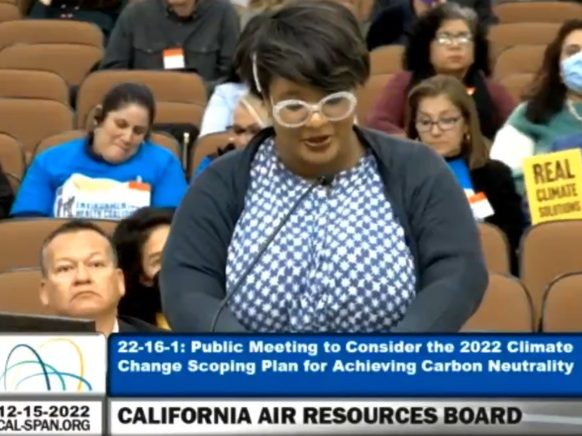Yesterday the California Air Resources Board adopted its 2022 "Scoping Plan," which outlines the policies and strategies that multiple state agencies will be expected to deploy in the coming years to fight climate change [PDF]. Lots is being written about the decision, but there are a couple of key points that seem to be getting lost in all the punditry.
One is that, as adopted, the scoping plan doubled the goals for reductions in driving (VMT, or vehicle miles traveled) over what it originally called for in the draft plan released in May. (That is, the VMT reduction goal was to reduce driving per capita by 12 percent below 2019 levels by 2030 and by 22 percent below 2019 levels by 2045; the adopted plan sets those numbers at 25 percent and 30 percent, respectively.)
The adopted plan also states plainly that the higher goal was added "in response to Board direction and EJ Advisory Committee (EJAC) recommendations" (which kinda seems to imply that CARB staff complied reluctantly).
CARB leaders have for several years been speaking out about the importance of reducing driving - making it clear that adopting strategies like shifting all of California's vehicles to electric won't be enough to meet state climate goals. But the agency has sidestepped taking the lead on figuring out how to hit those targets.
Even this scoping plan uses up some space writing about how hard the targets are to achieve while simultaneously pointing out why they are so important and how they fit in with all the other climate goals in the document:
Sustained VMT reductions have been difficult to achieve for much of the past decade, in large part due to entrenched transportation, land use, and housing policies and practices. Specifically, historic decision-making favoring single-occupancy vehicle travel has shaped development patterns and transportation policy, generating further growth in driving (and making transit, biking and walking less viable alternatives). These policies have also reinforced long-standing racial and economic injustices that leave people with little choice but to spend significant time and money commuting long distances, placing a disproportionate burden on low-income Californians, who pay the highest proportion of their wages on housing and transportation. While CARB has included VMT reduction targets and strategies in the Scoping Plan and appendices, these targets are not regulatory requirements, but would inform future planning processes.
Yup. It's too hard, and someone else will have to take charge, says CARB:
While CARB has included VMT reduction targets and strategies in the Scoping Plan and appendices, these targets are not regulatory requirements, but would inform future planning processes. CARB is not setting regulatory limits on VMT in the 2022 Scoping Plan; the authority to reduce VMT largely lies with state, regional, and local transportation, land use, and housing agencies, along with the Legislature and its budgeting choices.
Of course it won't be easy, and will require buy-in and support from many state and local entities. But CARB has been more than ready to pour time and money into carbon capture and sequestration (CCS), a technology that barely exists, may not even work, will definitely be expensive, and, if not done correctly, will continue to subsidize the fossil fuel industry, completely undermining other parts of this plan that call for reducing reliance on fossil fuels.
In other words, reducing driving is not impossible and may be a lot easier and more effective than investing in CCS.
The plan does at least lay out a few strategies that could help reduce VMT:
- Reimagine new roadway projects that decrease VMT in a way that meets community needs and reduces the need to drive.
- Invest in making public transit a viable alternative to driving by increasing affordability, reliability, coverage, service frequency, and consumer experience.
- Implement equitable roadway pricing strategies based on local context and need, reallocating revenues to improve transit, bicycling, and other sustainable transportation choices.
- Expand and complete planned networks of high-quality active transportation infrastructure.
- Channel the deployment of autonomous vehicles, ride-hailing services, and other new mobility options toward high passenger-occupancy and low VMT-impact service models that complement transit and ensure equitable access for priority populations.
- Streamline access to public transportation through programs such as the California Integrated Travel Project
Note that the third "strategy" outlined above must include an end to enabling driving by building and "improving" freeways and making them faster and easier than transit. Other state leaders are attacking this issue from different angles, but it has proven to be contentious - and also has the potential of being completely ignored.
Because CARB was clearly forced to take this stance, it remains to be seen whether staff will do more than give VMT reduction lip service while putting all their energy into the CCS basket.
By the way, this is far from the only issue raised by the EJAC about the draft plan. Members of the public and of the EJAC argued that CCS could be an expensive mistake while delaying real emissions reductions, for example. However, the focus on carbon capture was bolstered by recent legislation requiring the state to investigate its potential and remains a key strategy California plans to deploy somehow. (The "how" is another unknown, to be determined after another long planning process to begin next year.)
At last week's meeting, CARB also agreed - finally - to incorporate a permanent EJAC instead of just convening one whenever there is a scoping plan that needs public input. The EJAC will likely continue to put pressure on CARB to do better, but the public will need to keep speaking up about these issues to keep agencies from getting distracted by shiny objects like CCS.







